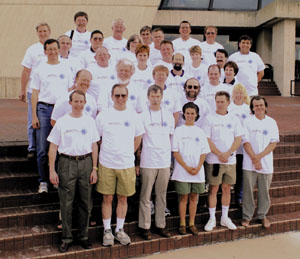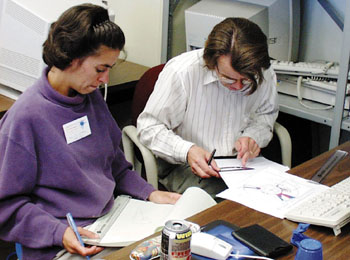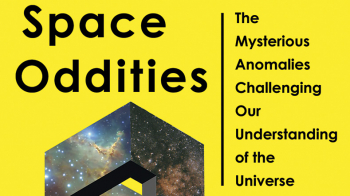Large international collaborations formed around experiments at CERN’s future LHC collider include outreach and education as part of their mission. Among the recipients of LHC data will be eager high school students.

The year is 2005, CERN’s LHC collider is running, and discoveries are on the horizon. Pete Bruecken and Jeff Dilks, high school teachers from Iowa, are telling students about their experiences of building detectors and carrying out beam tests at CERN. The students are even more interested when they learn that they will be analysing some new data from the LHC experiments that their teachers had a part in building.
As part of the QuarkNet programme, hundreds of teachers with similar experiences will have their students doing the first analyses of LHC datasets. These will be small datasets, filtered to be useful to students. This is an exciting opportunity because no-one else has analysed these data yet. There is always the possibility that the students will be part of an important discovery; the odds may be small but the potential is enormous. Furthermore, they will be communicating with students in other classrooms around the world, comparing notes about their findings and viewing the action at CERN, live via the Web. They will also be learning basic physics. Ultimately QuarkNet will reach 720 teachers and over 100 000 students.
Teachers Bruecken and Dilks were among 24 teachers who joined QuarkNet in 1999. After a week at Fermilab in June, learning about particle physics, they participated in seven weeks of research, which was funded by QuarkNet. Together with Professor John Hauptman at Iowa State University, Bruecken and Dilts constructed an incredibly fast detector, which, essentially, could collect energy and spatial information at the speed of light and then empty the calorimeter of signal in a nanosecond. Hauptman said, “The amazing thing about this module is that it was largely built on zero funds… and QuarkNet was essential for its success.”
The local newspaper reported, “Just imagine it: high school students watching cutting-edge particle physics experiments, analysing data and collaborating with scientists. How’s that for science homework?” QuarkNet plans to fly a number of students to CERN for the first physics runs so that they can report back on the events.
Introductory physics is present in much of high-energy physics. For students, concepts such as conservation of momentum and energy are ubiquitous. Particle physicists use these concepts as they study the fundamentals of nature. Why not let students explore classical physics through the lens of particle physics? Wouldn’t this bring much more interest to their studies?
QuarkNet seeks to create such a lens. The project’s main goal is to involve high school students and teachers in the ATLAS and CMS experiments as well as in Run 2 of the CDF and DØ experiments at Fermilab. A year ago, Keith Baker (Hampton University), Marge Bardeen (Fermilab), Michael Barnett (Lawrence Berkeley National Laboratory) and Randy Ruchti (University of Notre Dame) organized the project. To carry out the programme, QuarkNet has hired four teachers/educators to run the summer activities, assist the centres in the development of their programmes and help monitor the success of the project. QuarkNet is supported by the US National Science Foundation, the US Department of Energy and the participating universities and laboratories. While QuarkNet began in the US, there have been expressions of strong interest from CERN and from other European countries.
Teachers aboard experiments
QuarkNet invites teachers to join groups of particle physics experimenters (their mentors) for an eight-week summer research assignment. This immersion in research gives the teachers time to become familiar with the experiments and provides them with an overview of particle physics. Physicists, from a university or laboratory, recruit the teachers from nearby schools. The institution’s needs and the teacher’s personal skills determine the research assignment. QuarkNet provides a stipend (a salary) for these teachers and, for those who leave home for extended periods of time, living expenses.
During the academic year, teachers invite their students into the project by integrating some aspect of their summer work into their physics curriculum. This does not mean that students must study the Standard Model. Students could study the conservation of momentum via analysis of data from a collider event. They could also discover the vital role of computers in modern science by examining thousands of events: a task that is impossible to do by hand. They may consider protons moving through the LHC as they investigate the force that magnetic fields exert upon moving, charged particles. Each of these, and other curriculum ideas, will be developed by the teachers and QuarkNet staff as the programme matures.

During the school year, after their summer research assignment, QuarkNet teachers invite 10 other teachers from their area into the project. These associate teachers participate in a three-week institute, which is planned and hosted by the QuarkNet teachers and their local physicist mentors. Here they explore particle physics research and the classroom application of classical physics topics to the world of particle physics.
QuarkNet centres
This group of 12 teachers and at least two physicist mentors comprise a QuarkNet centre. During the summer of 1999, QuarkNet established 12 centres at universities and laboratories from California to Massachusetts, and in many places in between.
Teachers participated in a one-week orientation workshop at Fermilab in preparation for the summer research assignments. During the week, the teachers attended talks on everything from accelerators to cosmology, and enjoyed tours of CDF and DØ along with explanations of upgrades for Tevatron Run II. They worked with hand held cosmic-ray detectors brought from Notre Dame, and engaged in computer activities using Fermilab Run I data, computer simulations and material from the Web. The workshop featured time for teachers to pose questions to principal investigators Randy Ruchti and Michael Barnett and to synthesize a deeper understanding of physical phenomena. In addition, teachers discussed the classroom implementation of their research work on one of the four major collider experiments.
During their summer research the teachers took on varied and challenging projects. Larry Wray and Rosemary Bradley of Langston University in Oklahoma, under mentor Tim McMahon, worked on a project related to the “powers of ten”. Ulrich Heintz at Boston University involved Rick Dower in using LabView to write interface and data-collection software for measuring the characteristics of a silicon tracker wafer to be used in DØ. He did this and then repeated his measurements in a neutron beam, generated by the low-energy (approximately 4 MeV) proton accelerator at the University of Massachusetts in Lowell, to test the effect of radiation on the wafer.
The CMS project
Much of the work for QuarkNet 1999 involved the CMS project at CERN. Kevin McFarland, of the University of Rochester, had Susen Clark and Paul Pavone test the long-term stability of scintillating crystals (to be used as reference standards for CMS). These two teachers also built a “muon telescope” cosmic-ray detector for classroom demonstrations. The work of the Iowa centre in CMS was explained well by John Hauptman of Iowa State University: “Nural Akchurin in Iowa City and I, in Ames, have a lot of good work to do, and Jeff [Dilks] and Peter [Bruecken] were right in the middle of it. Peter analysed radiation damage data, designed and built mechanical mounts for a new calorimeter, and next week he will start taking data in the LEP injector beam at CERN. Jeff was responsible for designing and building a new calorimeter in Ames, testing it at CERN this summer, and analysing data from it.”
At Notre Dame, LeRoy Castle and Dale Wiand worked with Randy Ruchti to design Optical Decoder Units (ODUs) for CMS. Both teachers became involved in negotiation with other CMS production sites to find satisfactory solutions to questions on how to best place the ODUs in the detector structure.
How does this experience influence teaching and learning? Students in Ames, Iowa were performing an experiment in their physics class. They had divided up the parameter space of a dataset so that they could save class time, but still cover the necessary measurement parameters. Jeff Dilks had his students share their measurements by writing their data on the white board. A plot of the measurements showed absolutely nothing. Over the weekend Dilks considered his options. He resolved to use this opportunity to show his students that science does not always yield what is expected.
On the Monday he started class by informing the students that their work truly models what goes on in the “real world” of science. The results that they had shared on Friday were nonsense and indicated that new and more precise measurements were required. The class discussed what changes could be made, assigned parameters and performed their measurements once again. This time a quick plot of those measurements showed some interesting results. The lesson was learned; science is an involved process that has starts and stops, and it often yields results that beg more questions.








